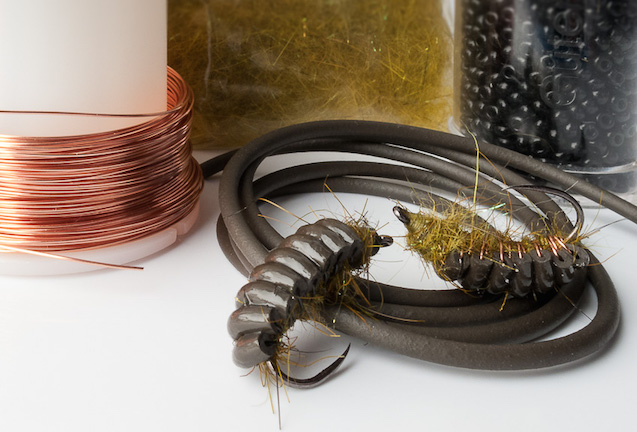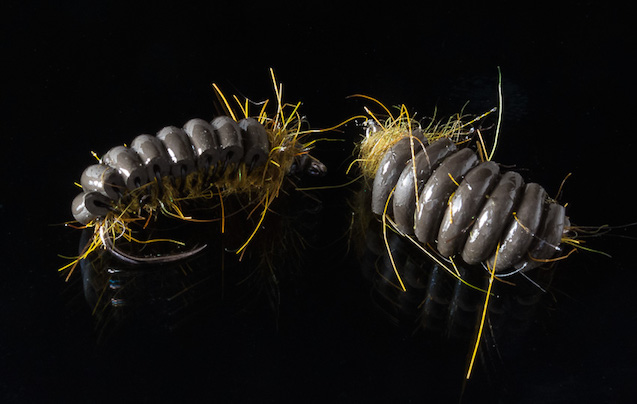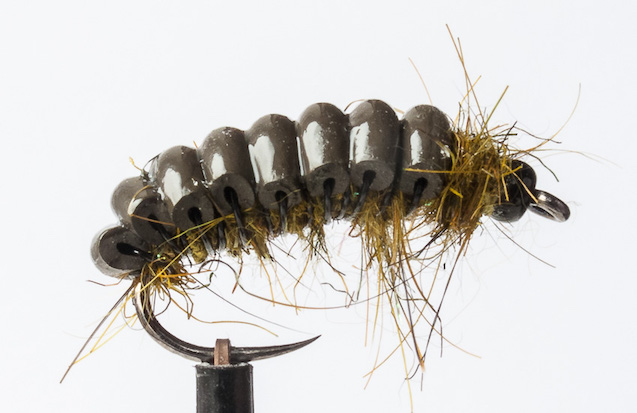Here's a great pattern to add to your fly box from Nick Thomas
Whenever I go into a fishing shop, whether actual or virtual, I always have a browse around the other sections for stuff that might prove useful apart from the fly fishing or tying gear I went in for. In the past, this has stimulated some good new fly patterns, such as the No-Tie (ESF #26), which uses silicone rig stops used by carp anglers. This time it was another bit of the plethora of gear designed to separate carp angler and cash that caught my eye. Tungsten rig tubing is used to sink a carp angler’s mainline onto the lake bed and camouflage it to stop it spooking the fish. I find it strange that they feel it necessary, given that I fish for carp with a bright orange fly line and that doesn’t bother them in the least. Some of them try to eat it. But I guess if you are waiting for hours or days in a cold damp bivvy for a fish to spring your trap, anything that increases confidence may help.

Rig tubing is made from soft bendy plastic mixed with tungsten powder, it’s about 2mm in diameter, weights around 10g/metre and is available in a range of different camouflage colours. I bought a pack for a few quid, figuring it might be useful for adding a bit of weight to nymphs. Then I puzzled for quite a while over what I could do with it. It sat in the corner of my tying bench for a couple of months while I picked it up, tried something out and then abandoned the idea. I knew there was a fly in there, I just couldn’t figure it out.
The tubing is too thick just to wrap around a hook to add weight and it tends to break at the tying in point if you stretch it too much. In any case lead wire or foil would be heavier and cheaper for hidden weight. I did find it was useful for making flattened nymph underbodies by tying sections on either side of the hook shank and it added a bit of weight at the same time. The tubing can be tapered with an angled cut at either end and thread tension used to compress it where required to make either smooth or segmented underbodies.
To overcome the tendency of the tube to break under tension I tried threading some 15lb nylon through the tube and then tying it in sections to form a segmented back on a nymph. I thought I was really onto something. I wasn’t. It was a nightmare. I couldn’t get anything to stay in place as the springiness of the monofilament kept shifting the body segments around. Then I tried copper wire instead; that’s the way to do it. Using segments of tube threaded onto a wire rib over a dubbed body yielded a pretty passable imitation of a hoglouse.

The hoglouse, or water slater, is the aquatic equivalent of the common or garden woodlouse, those little critters that curl up or scurry away when you are tiding up weeds or leaves in the garden. They live among the silt and vegetation on the bottom of lakes or in the slow flowing margins of rivers, feeding on decaying organic matter. They don’t move very fast so provide a good source of food for prospecting fish. In the cold of winter when active fly life is scarce and fish are rooting around on the bottom after food, it’s worth having a few in your fly box.

Hook Hends BL554 black nickel size 8 to 12
Thread Veevus 10/0 olive
Head Black glass embroidery bead (optional)
Underbody Olive dubbing
Rib Copper wire, natural or black
Back Tungsten carp rig tubing
-
Thread on a glass bead if you are using one and then run on the tying thread. Catch in the end of a 15cm length of copper wire and tie in along the hook shank part way round the bend.
-
Dub a chunky tapered body, whip finish at the bead or hook eye and cut off the thread.
-
Make a turn of wire onto the bare hook shank at the back of the dubbed body.
-
Cut a short section of tungsten tube and slide down the wire to the back of the body. Lift the wire and while holding the tube in place over the dubbed body, take a turn of wire under the body.
-
Repeat with further sections of tungsten tube increasing and then decreasing the lengths of successive segments to form the back of the hoglouse.
-
After the last segment has been secured with two turns of wire, reattach the tying thread, tie down the wire and waggle the waste end to break it off.
-
Apply some more dubbing to the thread and build up a ball of dubbing between the last segment of tube and the bead/hook eye.
-
Smear the thread with varnish or superglue, whip finish and cut the thread.
-
Use Velcro or a dubbing needle to pick out the dubbing under the body and then give the back a couple of coats of varnish or UV resin.
The Tungsten Hoglouse is a very fine pattern to have in your box for grayling in the autumn and winter when a flooding river has displaced the little beasties from the marginal vegetation. Using 5-7cm of tubing on gives a fly weighing 0.5g to 0.7g, pretty much what you’d get using 4 or 4.6mm tungsten beads and well suited for short line nymphing in deep flowing water. I’ve been using the pattern a lot this winter and it features in this video.
Nick Thomas lives in South Wales. He started fly fishing on Scottish hill lochs many years ago and continues to design, tie and fish flies for trout, grayling, carp, bass and anything else that’s going.